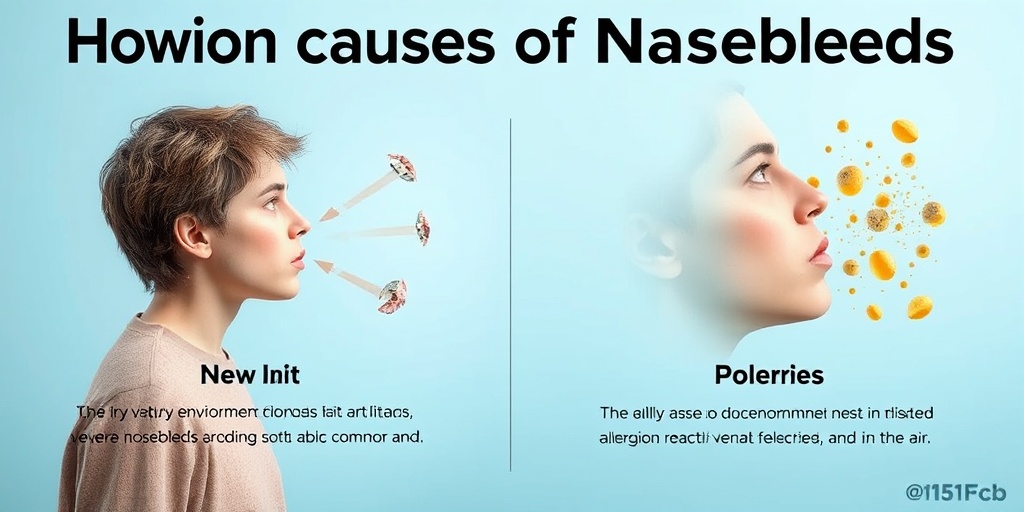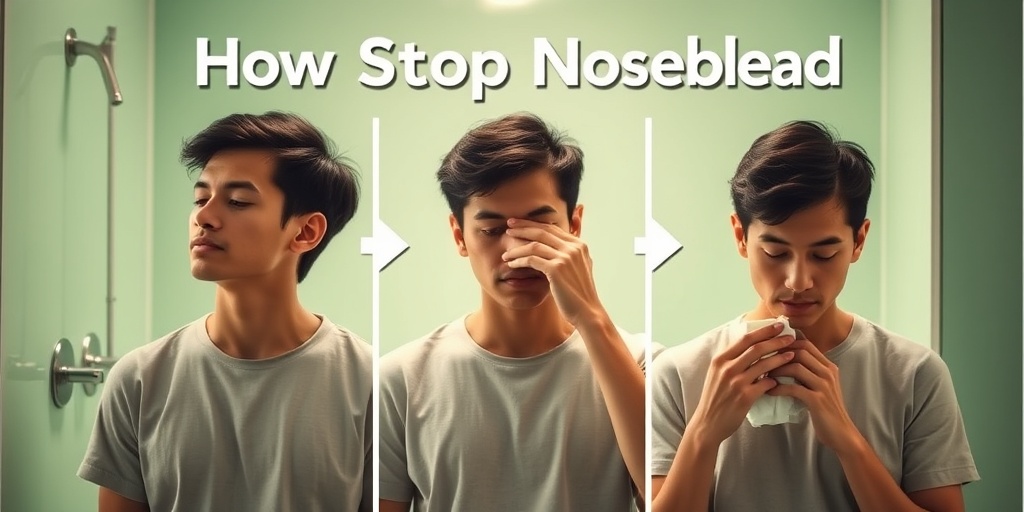What Is a Nosebleed?
A nosebleed, medically known as epistaxis, occurs when the delicate blood vessels in the nasal passages rupture, leading to bleeding from the nostrils. While they can be alarming, nosebleeds are quite common and usually not serious. They can happen to anyone, but certain factors can increase the likelihood of experiencing one.
Nosebleeds can be classified into two main types:
- Anterior Nosebleeds: These are the most common type, occurring in the front part of the nose. They are usually easy to manage and often result from minor injuries or environmental factors.
- Posterior Nosebleeds: These are less common but can be more serious. They occur deeper in the nasal cavity and may require medical attention, especially if the bleeding is heavy.
Common Causes of Nosebleeds
Nosebleeds can be triggered by a variety of factors. Understanding these causes can help you prevent them and know how to respond effectively when they occur. Here are some of the most common causes:
1. Dry Air
One of the leading causes of nosebleeds is dry air. This is particularly common in winter months or in arid climates. The lack of moisture can dry out the nasal membranes, making them more susceptible to cracking and bleeding.
2. Allergies and Sinus Infections
Allergies can lead to inflammation and irritation of the nasal passages, increasing the risk of nosebleeds. Similarly, sinus infections can cause swelling and congestion, which may also contribute to bleeding.
3. Nose Picking and Trauma
Engaging in activities like nose picking or experiencing trauma to the nose (such as a sports injury) can easily damage the blood vessels in the nasal lining, resulting in a nosebleed. It’s essential to discourage children from picking their noses to minimize this risk.
4. Medications
Certain medications, particularly blood thinners and nasal sprays, can increase the likelihood of nosebleeds. If you are on medication and notice frequent nosebleeds, consult your healthcare provider for advice.
5. Underlying Health Conditions
In some cases, frequent nosebleeds may indicate an underlying health issue, such as a bleeding disorder or high blood pressure. If you find that your nosebleeds are persistent or severe, it’s crucial to seek medical attention.
6. Environmental Irritants
Exposure to irritants like smoke, strong odors, or chemicals can also lead to nosebleeds. These irritants can dry out or inflame the nasal passages, making them more prone to bleeding.
7. Hormonal Changes
Hormonal fluctuations, particularly during pregnancy, can increase blood flow to the nasal membranes, making them more susceptible to bleeding. Pregnant women should be aware of this and take preventive measures.
How to Stop a Nosebleed
Knowing how to effectively manage a nosebleed is essential. Here are some steps you can take to stop a nosebleed:
- Stay Calm: Anxiety can increase blood pressure, making the bleeding worse.
- Pinch Your Nose: Pinch the soft part of your nose and lean forward slightly. This helps to apply pressure to the bleeding site.
- Use Ice: Applying a cold compress or ice pack to the back of your neck can help constrict blood vessels and reduce bleeding.
- Avoid Lying Down: Lying flat can cause blood to flow down the throat, which may lead to swallowing blood.
If the bleeding does not stop after 20 minutes or if you experience frequent nosebleeds, it’s advisable to consult a healthcare professional. For those looking for effective solutions, products like nosebleed stopping sprays or a nosebleed stopping kit can be beneficial. You can find more information and resources at Yesil Health AI.
In conclusion, while nosebleeds can be concerning, they are often manageable with the right knowledge and techniques. By understanding the common causes and knowing how to stop a nosebleed, you can feel more prepared and less anxious when they occur. 🌟

Symptoms of Nosebleeds
Nosebleeds, also known as epistaxis, can be alarming, but they are often harmless. Understanding the symptoms can help you manage the situation effectively. Here are some common signs to look out for:
Types of Nosebleeds
Nosebleeds can be categorized into two main types:
- Anterior Nosebleeds: These are the most common type, occurring in the front part of the nose. They usually result from the rupture of small blood vessels and are often easy to control.
- Posterior Nosebleeds: Less common but more serious, these occur in the back of the nose and can lead to heavier bleeding. They may require medical attention.
Common Symptoms
When experiencing a nosebleed, you may notice the following symptoms:
- Blood Flow: Blood may flow from one or both nostrils. The color can vary from bright red to dark red, depending on the source of the bleeding.
- Feeling of Fullness: You might feel a sensation of fullness or pressure in your nose.
- Swallowing Blood: If blood drips down the back of your throat, you may swallow it, which can lead to nausea.
- Lightheadedness: In cases of significant blood loss, you may feel dizzy or lightheaded.
Recognizing these symptoms can help you determine the severity of the nosebleed and whether you need to seek medical help. If a nosebleed lasts longer than 20 minutes or is accompanied by heavy bleeding, it’s essential to consult a healthcare professional. 🚑
How to Stop a Nosebleed
Knowing how to stop a nosebleed effectively can make a significant difference in managing the situation. Here are some tried-and-true methods to help you or someone else stop a nosebleed quickly:
Immediate Steps to Take
When a nosebleed occurs, follow these steps:
- Stay Calm: Anxiety can increase blood pressure, making the bleeding worse. Take a deep breath and stay calm.
- Positioning: Sit up straight and lean slightly forward. This position helps prevent blood from flowing down the throat, which can cause choking or nausea.
- Pinch the Nose: Using your thumb and index finger, pinch the soft part of your nose shut. Maintain this pressure for about 5 to 10 minutes without releasing it.
- Apply Ice: Placing a cold compress or ice pack on the bridge of your nose can constrict blood vessels and help stop the bleeding. 🧊
Using Nosebleed Stopping Products
There are various products available that can assist in nosebleed stopping. These include:
- Nosebleed Stopping Spray: These sprays can help constrict blood vessels and promote clotting.
- Nose Bleed Stopping Kit: A kit may include items like nasal sprays, gauze, and instructions for managing nosebleeds effectively.
When to Seek Medical Attention
If the nosebleed does not stop after 20 minutes of applying pressure, or if it occurs frequently, it’s crucial to consult a healthcare professional. Additionally, if you experience:
- Heavy Bleeding: Blood loss that is significant or continues to flow.
- Difficulty Breathing: If you have trouble breathing or swallowing.
- Signs of Shock: Symptoms like rapid heartbeat, confusion, or extreme weakness.
Understanding how to stop a nosebleed and recognizing when to seek help can empower you to handle this common issue effectively. Remember, while nosebleeds can be unsettling, they are often manageable with the right techniques and knowledge. 🌟

Home Remedies for Nosebleeds
Nosebleeds, while often alarming, are usually harmless and can be managed effectively at home. Here are some home remedies for nosebleeds that can help you stop the bleeding quickly and comfortably.
1. Pinch Your Nose
One of the most effective methods for nosebleed stopping is to pinch your nose. Here’s how to do it:
- Sit up straight and lean slightly forward to prevent blood from flowing down your throat.
- Using your thumb and index finger, pinch the soft part of your nose.
- Maintain pressure for about 5 to 10 minutes without releasing.
This method helps compress the blood vessels and can significantly reduce bleeding. 🩸
2. Apply Ice
Using ice can also be beneficial in stopping nosebleeds. Here’s what you can do:
- Wrap ice in a cloth or use a cold pack.
- Place it on the bridge of your nose for about 10 minutes.
The cold temperature constricts blood vessels, which can help in reducing the bleeding. This method is particularly useful for stopping nosebleed in kids who may find it easier to tolerate. ❄️
3. Humidify Your Environment
Dry air can lead to nosebleeds, especially in winter months. Using a humidifier in your home can help maintain moisture in the air, reducing the likelihood of future nosebleeds. Make sure to:
- Keep the humidifier clean to prevent bacteria growth.
- Set it to a comfortable humidity level (around 30-50%).
This simple adjustment can make a significant difference in preventing nosebleeds. 🌬️
4. Stay Hydrated
Drinking plenty of fluids is essential for maintaining healthy mucous membranes. Ensure you:
- Drink at least 8 glasses of water a day.
- Include hydrating foods like fruits and vegetables in your diet.
Staying hydrated can help keep your nasal passages moist, reducing the risk of bleeding. 💧
5. Use Saline Nasal Spray
Saline nasal sprays can help keep your nasal passages moist. You can use them as follows:
- Spray into each nostril as directed.
- Use it several times a day, especially in dry conditions.
This can be particularly helpful for those who experience frequent nosebleeds. 🌿
When to Seek Medical Help
While most nosebleeds can be managed at home, there are instances when you should seek medical attention. Here are some signs to watch for:
1. Frequent Nosebleeds
If you find yourself experiencing nosebleeds not stopping or having them frequently, it’s essential to consult a healthcare professional. This could indicate an underlying health issue that needs to be addressed.
2. Heavy Bleeding
If the bleeding is heavy and lasts longer than 20 minutes despite applying pressure, it’s time to seek medical help. Heavy bleeding can lead to complications and may require professional intervention.
3. Blood Thinning Medications
If you are on blood-thinning medications or have a bleeding disorder, it’s crucial to consult your doctor if you experience a nosebleed. They can provide guidance on how to manage the situation safely.
4. Other Symptoms
If your nosebleed is accompanied by other symptoms such as dizziness, weakness, or difficulty breathing, seek immediate medical attention. These could be signs of a more serious condition. 🚑
Understanding how to manage nosebleeds effectively can help alleviate anxiety and ensure you’re prepared for any situation. Remember, while home remedies can be effective, don’t hesitate to reach out to a healthcare professional if you have concerns. Your health is paramount! 🌟

Preventing Future Nosebleeds
Nosebleeds can be a nuisance, but the good news is that many can be prevented with a few simple lifestyle changes and precautions. Understanding the causes of nosebleeds is the first step in preventing them from occurring in the future.
Stay Hydrated
One of the most effective ways to prevent nosebleeds is to keep your nasal passages moist. Dry air, especially during winter months or in arid climates, can lead to dryness and irritation. Here are some tips to stay hydrated:
- Drink plenty of water: Aim for at least 8 glasses a day to keep your body and nasal passages hydrated.
- Use a humidifier: Adding moisture to the air can help prevent dryness in your home.
- Saline nasal sprays: These can be used to keep your nasal passages moist throughout the day.
Avoid Nose Picking
Nose picking is a common habit that can lead to nosebleeds. The delicate blood vessels in the nasal lining can easily rupture when disturbed. To avoid this:
- Keep nails trimmed: Short nails can reduce the risk of injury when touching your nose.
- Use tissues: If you feel the urge to pick, use a tissue instead to minimize damage.
Manage Allergies and Sinus Issues
Allergies and sinus infections can lead to inflammation and increased susceptibility to nosebleeds. Here’s how to manage these conditions:
- Consult a doctor: If you have persistent allergies, seek medical advice for appropriate treatments.
- Use antihistamines: These can help control allergy symptoms and reduce nasal irritation.
Protect Your Nose
Physical activities or injuries can also lead to nosebleeds. To protect your nose:
- Wear protective gear: If you’re involved in contact sports, use a face mask or helmet.
- Avoid harsh environments: If you work in a dusty or chemical-laden environment, consider wearing a mask.
Nosebleed Myths and Facts
There are many misconceptions surrounding nosebleeds that can lead to unnecessary panic or ineffective treatments. Let’s debunk some common myths and provide the facts.
Myth 1: Nosebleeds Only Happen in Dry Weather
Fact: While dry air can contribute to nosebleeds, they can occur in any season or climate. Factors such as allergies, sinus infections, and even high blood pressure can also lead to nosebleeds.
Myth 2: You Should Tilt Your Head Back
Fact: Tilting your head back during a nosebleed can cause blood to flow down the throat, which may lead to choking or swallowing blood. Instead, lean forward to allow the blood to drain out of the nose.
Myth 3: Nosebleeds Are Always Serious
Fact: Most nosebleeds are not serious and can be treated at home. However, if a nosebleed lasts longer than 20 minutes or occurs frequently, it’s essential to consult a healthcare professional.
Myth 4: Nosebleeds Are Only a Problem for Kids
Fact: While children are more prone to nosebleeds due to their habits and developing nasal structures, adults can also experience them, especially if they have underlying health issues.
Myth 5: You Need to Use Cotton Balls to Stop a Nosebleed
Fact: While some people may use cotton balls, they can absorb blood and make it difficult to monitor the bleeding. Instead, use a clean cloth or tissue and apply gentle pressure to the nostrils.
Understanding these myths and facts can empower you to handle nosebleeds more effectively and reduce anxiety associated with them. Remember, knowledge is key to nosebleed stopping and prevention! 🌟

Frequently Asked Questions about Nosebleed Stopping
What are the best methods for nosebleed stopping?
There are several effective methods for nosebleed stopping. Some of the most recommended techniques include:
- Pinching the nostrils together and leaning forward.
- Applying a cold compress or ice pack to the nose.
- Using a nosebleed stopping product or spray specifically designed for this purpose.
- Keeping the head elevated to reduce blood flow to the nasal area.
How can I stop a nosebleed in kids?
Stopping a nosebleed in children can be similar to adults, but it’s important to remain calm. Here are some tips:
- Have the child sit up straight and lean slightly forward.
- Pinch the soft part of the nose and hold for about 10 minutes.
- Encourage them to breathe through their mouth.
- If the bleeding doesn’t stop, consider using a nosebleed stopping kit designed for children.
What should I do if my nosebleed is not stopping?
If a nosebleed is persistent and not stopping, it’s crucial to seek medical attention. Here are some steps to take:
- Continue pinching the nostrils and leaning forward.
- Apply a cold compress to the nose.
- Stay calm and avoid any strenuous activity.
- If bleeding lasts longer than 20 minutes, consult a healthcare professional.
Can ice help in stopping nosebleeds?
Yes, applying ice can be beneficial in stopping nosebleeds. The cold helps constrict blood vessels, which can reduce bleeding. Here’s how to use ice effectively:
- Wrap ice in a cloth or use a cold pack.
- Apply it to the bridge of the nose for 10-15 minutes.
- Combine this with pinching the nostrils for better results.
Are there any products specifically for nosebleed stopping?
Yes, there are various nosebleed stopping products available, including:
- Nosebleed stopping spray that helps to clot the blood.
- Specialized nasal gels that moisturize and protect the nasal lining.
- Pre-packaged nosebleed stopping kits that include all necessary supplies.
What causes a nosebleed to start and stop?
Nosebleeds can start due to various factors such as dry air, allergies, or nasal injuries. They may stop when:
- The underlying cause is addressed (e.g., humidity is increased).
- Pressure is applied effectively to the nose.
- Medical intervention is provided if necessary.
When should I see a doctor for a nosebleed?
If you experience frequent nosebleeds or if a nosebleed lasts longer than 20 minutes despite applying pressure, it’s advisable to consult a doctor. Additionally, if you notice other symptoms such as dizziness or excessive bleeding, seek medical help immediately. 🩺




